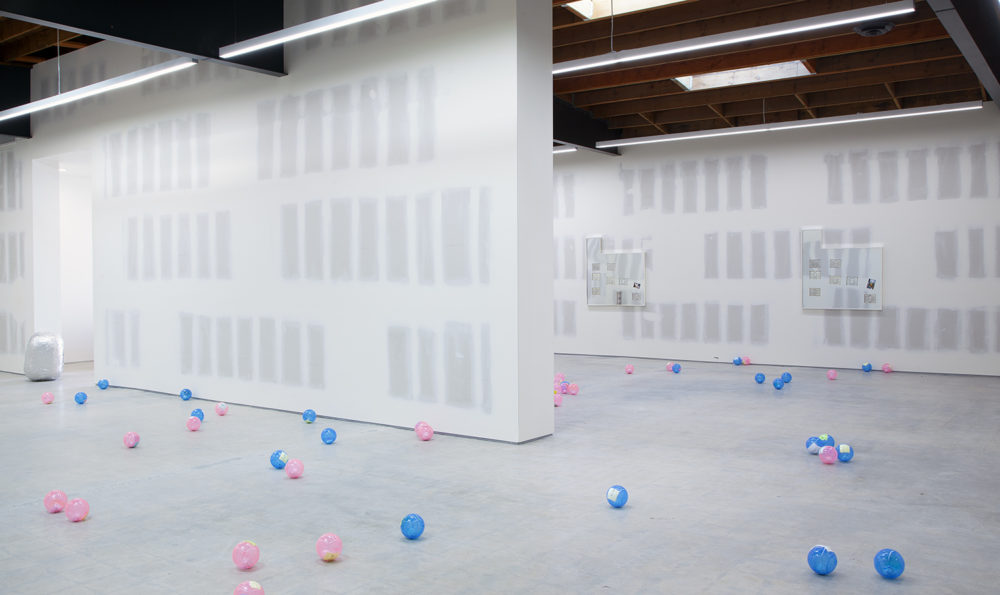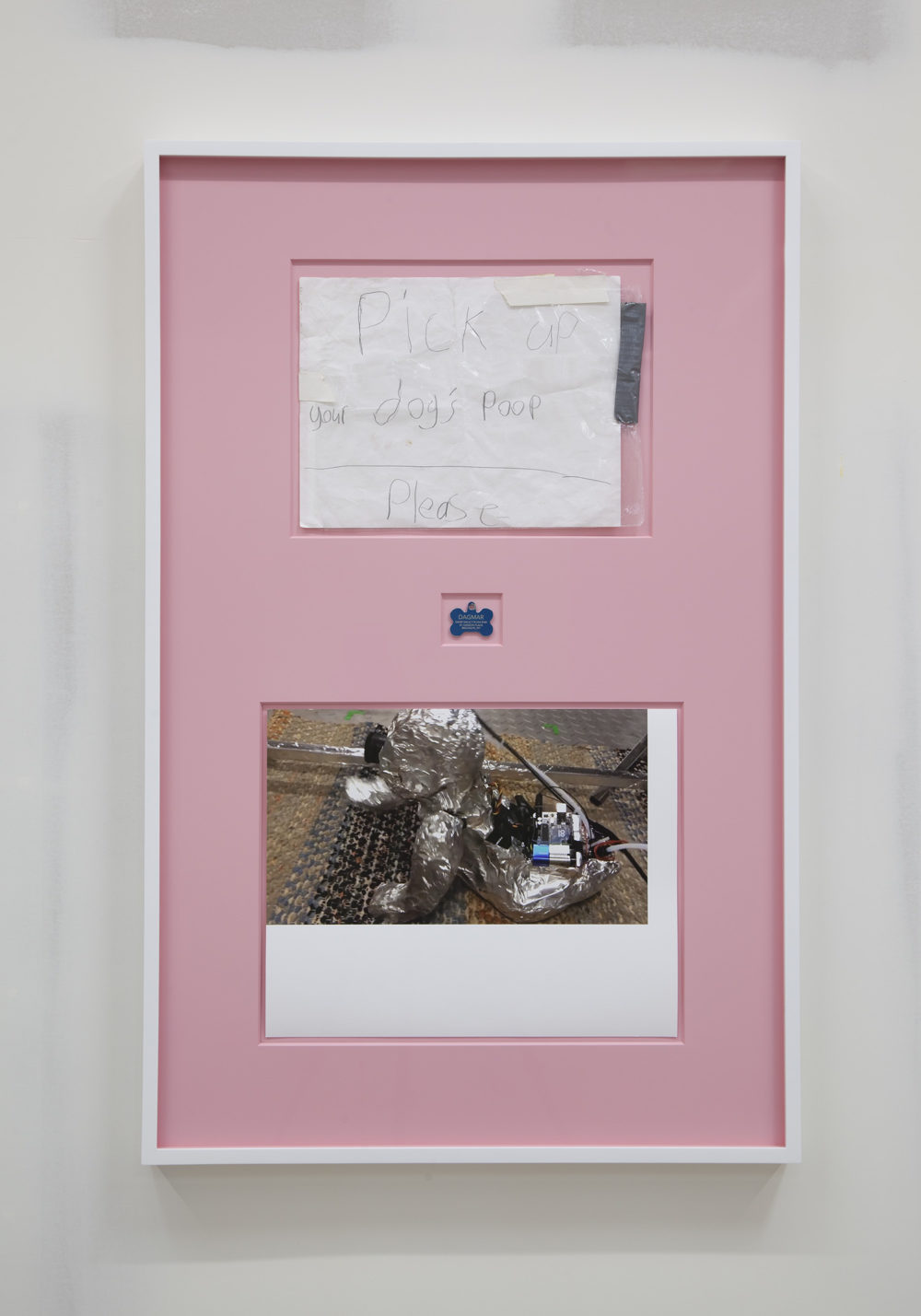
- Source: Texte Zur Kunst
- Author: Mark Pieterson
- Date: December, 2021
- Format: Print
INSIDE, LOOKING OUT
Mark Pieterson on SoiL Thornton at Morán Morán, Los Angeles

“SoiL Thornton: My child will be named after me, Invasive, or was it Prayer? I need to check my notes,” Morán Morán, Los Angeles, 2021, installation view
The art market gleefully co-opts critique and political inquiry when they suit its interests, yet it also clings tightly to values and structures fundamentally at odds with those critiques. Are shifts in language and repre- sentation enough to address the pervasive inequities of the market? Writer and curator Mark Pieterson asks this question in looking at SoiL Thornton’s recent show in Los Angeles, which took up the difficult relationship between labor and commerce. Pieterson investigates the extent to which the exhibited work can truly provide an alternative to the pernicious features of capitalism and concludes that, in centering indeterminacy as a mode of being and as a means of production, Thornton’s work indeed offers a successful form of resistance.
SoiL Thornton’s third solo exhibition with Los Angeles gallery Morán Morán, My Child will be named after me, Invasive, or was it Prayer? I need to check my notes., showcases the artist’s foray into a conceptual field interested in the inter- play of labor, identity, and material culture. The show consists of ten works (all 2021, unless where noted) – made mostly from appropriated and found materials – that sprawl across the gallery’s two main rooms. Thornton uses the grammar of deconstruction and vulnerability to question and highlight the relationship between labor and commerce. As a whole, the cacophonous installation encompasses a form of distended mark-making that implicates space, place, and difference as significant exponents of self-determination.

The untreated white-and-gray gallery walls stand out immediately, as if the space is still in the middle of construction. Because it’s the first show in the gallery’s new space, it’s easy to assume that architectural modifications are ongoing. However, when asked, owner Mills Morán notes that the decision to keep the walls untreated was a deliberate choice by the artist as a way to frame the show. In fact, the walls themselves are listed as an artwork, aptly titled In highest preparation for becoming. Doing so exposes the gallery’s utility as a dynamic site of knowledge production and capital circulation. Thornton also obliges us to consider the ways in which the built environment orients and provides a container for the articulation of subject positions and social gestures. Because of the gallery’s seemingly unfinished state, the objects within it resist clearly defined semiotic boundaries, allowing them to exist in a state of relational becoming.
Several pink and blue hamster balls lie sparingly on the floor throughout the gallery. Each is adorned with names of the artist’s friends written on paper and taped to the surface. Some of the names are written in ink, while others are composed in graphite and colored pencil. For this piece, 101 impressions (people crush)(it takes a village), the artist invited friends to contribute to its creation, mailing them the balls and asking recipients to insert balled up aluminum foil in them.* The work explicitly unravels the often veiled artistic process and complicates notions of authorship and provenance. In delegating to friends a step in the work’s production, Thornton makes a symbolic nod to Fordism in the installation, begging the question: To what extent are kinship systems structured by the machinations of capitalism?
At the same time, blue and pink, as common referents for binary gender, are used ubiquitously in contemporary birth rituals known as “gender reveals.” Instead of sending each friend a ball according to the recipient’s gender, Thornton mailed them randomly.* This action disregards the color assignment’s power of representation, dispelling its codified performance. In doing so, the work opens up the possibility for people to occupy multiple social locations, allowing for indefinitely malleable identity. Thornton encourages viewing the farce of normativity as the limiting cofactor in maintaining the elasticity of subjectivity.
This notion of difference as an emergent property of space and place finds further kinship in three compelling mirrored-finish stainless steel works, Flagged Identity 2 through 4. Framed in white gold leaf and hung on the wall, these thick L-shaped surfaces contain archival pigment prints of the artist’s inactive and active bank card chips floating alongside found photos. The mirrored surface of each of these pieces has the effect of collapsing the entire gallery installation and viewer into a single frame, activating a participatory element to the work that refutes visitors’ sense of themselves as passive agents. Rather than explicitly voicing a call to action, Thornton gives room for more meditative, recursive responses to the fraught field of signifiers.
Yet, the extent to which these works, in their conceptual posturing, can truly provide an alterity to the pernicious features of capitalism remains a point of contention. An untenable feature of capitalism is its historical ability to subsume fringe activity as part of its organizing principle; Thornton’s deliberate eschewal of a traditional press release seems to serve as an indictment of the market’s flaws, asking whether structured changes in language and representation with respect to intersections of race, gender, and class are enough to solve the often-discussed inequities of the market. Perhaps not.
There are also other points to consider. Although Flagged Identity and In highest preparation for becoming question the transparency and legibility that make the practice of artists of color and of those whose sexuality diverges from white heteronormativity attractive to collectors, they unfortunately do not propose any new contractual solutions. Nor do they adequately address the exploitation of surplus value and social capital that alienate the artist from their work, as the anarchic conceptual practices of Stanley Brouwn and Cameron Rowland, for example, have done. Thornton’s attempt to disrupt these very hierarchies isn’t fruitful; instead, the hierarchies are rendered as ineluctable content. For much of the show, the extent to which Thornton’s critical position takes precedence over their own participation in the machinations against which they posture remains in question. Thornton’s ambivalence can be seen here not as a hesitancy to bite the hand that feeds them, but as definitive uncertainty toward the calls for diversity and inclusion championed by many arts institutions during the cultural reckoning of 2020. Thornton seems to ask: What else are we missing when visibility alone doesn’t cover the full range of the art world’s issues?
Continuing along these lines, the tripartite, pink-matted piece Subject in neighborhood ≥ subjecthood relays the reflexively dichotomous relationship between the built environment and the fluid makeup of personhood. The visually arresting, white-framed piece is made up of a water-resistant note, a dog tag (both found objects), and an archival print of an “infant and adult inhalation exposure robot.” In this work, one gets an immediate feel for Thornton’s choreography in space; their daily movements are reified, effectively anchored by their body as a primary contact point for shifting registers of belonging. The found objects that comprise the piece can be viewed as archival cofactors that provide a glimpse into the semiotic relationship between social texts and entropic sensorium.
Adjacent to Subject in neighborhood is a distressed wooden chair sculpture titled Every piggy grows into bonds if it eats stock (hopes expansion and contraction), 2017–21. The wicker seat of the chair is destroyed – completely frayed as if punched through in a fit of therapeutic frustration. Taped to the chair’s exterior frame and four legs is a transparent support system that also serves as a container for real and fake coins. Once again, Thornton calls attention to the creation of value. Because of our reflexively dichotomous relationship to capital and its classed metrics of valuation, the resulting tension in the teleological slippages from furniture to art object plays a key role in the sculpture’s affective resonance.
Not even the currency applied to the structural support can provide lasting comfort. Thinking through this proposition, the idea is posited that a successful remedy to capitalism’s inexorable clutches lies in the conscious (re)configuration of the relationship we have to its beguiling comforts. Embracing uneasiness–antithetical to the market’s affinity for calculated, predictive outcomes–may actually not be a bad thing. In fact, it could be the catalyst to forging alternative realities.
Thornton’s reticence to confer any set answers to commerce’s antagonisms offers a clever distance from the interpretative violence that limits self-determination. From the mirrored call-and-response engagement that Flagged Identity enacts to the haphazard placement of 101 impressions (people crush)(it takes a village), indeterminacy is centered as a mode of being and means of production, resulting in interesting shifts in conceptual registers throughout the exhibition. For an installation that addresses the fallacy of binaries and the ambiguities of belonging, treating its contextual imbrications as features of difference rather than as fixed assertions dislocates the idea that the only way to move beyond capital’s discontents is to either voice complaint or exit. Like Thornton, maybe we too can benefit from strategic play as a viable form of resistance.
*Paragraphs 4 and 5 incorrectly state that the hamster balls in 101 impressions (people crush)(it takes a village) were mailed to recipients.

